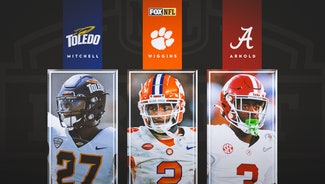
In Southern California, An NFL D-League Grows
For years, NFL coaches, front office personnel and players on the fringes of rosters have griped over the absence of a developmental league. Even some in the NFL league office, most notably VP of Football Operations Troy Vincent, have joined the chorus.
A D-league, following the spirit of NFL Europe, could provide a haven for dozens of players struggling to navigate the choppy waters between college and professional football. And for those players, last week brought a welcome announcement. Don Yee, best known as Tom Brady’s agent, revealed he is launching a new professional league. Yee’s Pacific Pro Football aims to begin play in 2018, with four teams based in Southern California. This is not the conventional developmental league Vincent has called for, but it is an intriguing complement.
The Pacific Pro League would only employ players not yet eligible for the NFL. Players would receive, on average, $50,000 a year, though multiple people briefed on the idea stressed there might not be a cap (a star running back, for example, could earn $100,000, plus opportunity for endorsements). Yee has promised that the style and schemes would mimic professional football, not college.
“I’d still like to see a more traditional D-league, but if this actually comes through, those two entities can co-exist,” explains a high-ranking executive in an NFL front office. “Yee’s league seems like a promising concept. It addresses a few areas of concern we’ve been seeing [regarding] the gap between college and our game. I’m looking forward to hearing more about it.” Adds The MMQB’s Andrew Brandt: “We’ve seen professional leagues come and go, but it has always competed with the NFL product. This project, in a sense, is competing with college.”
The PPL addresses the growing stylistic divide between the collegiate and professional games while rectifying college football’s most sensitive pressure point: properly compensating its athletes. But what type of player would choose to play in this league and forgo college football, the NFL’s natural feeder program? One NFL scout was skeptical the startup league could pull top talent. “Elite recruits are always, in my opinion, going to want to go to the elite programs and compete against the best competition, and for championships,” he says. “This league won’t pit the best against the best; this will be middle-of-the-road recruits or student-athletes that got buried on the depth chart [and] bail on college early and seek the money of that league.”
Longtime agent Leigh Steinberg offered a different take: “As much as you and I might want every young adolescent to matriculate in college and lay a solid foundation for the rest of their life, many of these guys simply don’t have interest in college. We can be judgmental and say, every player should have a profound interest in preparing for a second career, but the truth is sometimes these kids go to college with the sole motivation of biding time, the three years removed from high school, until they can enter the NFL.”
The Pacific Pro League might also attract special exception cases. Brandt brought up Maurice Clarett and Mike Williams. In 2004, the two were among nine players who declared for the NFL draft after Clarett successfully sued the NFL to allow him into the draft despite being only two years removed from high school. When the ruling was overturned on appeal, both players were locked out of the draft and also ineligible to return to school (Clarett had already been dismissed from Ohio State, Williams had been on good terms at USC). They trained on their own for a year, Williams going 10th overall to the Detroit Lions and Clarett third round to the Denver Broncos in 2005. Neither four success in the NFL, and perhaps their paths would have been different if they had the option of a league like the PPL.
Additionally, a scout explained the Pacific Pro League could be “for a guy in an SEC program who doesn’t qualify academically, then instead goes to this league instead of FCS or JUCO.”
No matter how much dysfunction the NCAA harbors, the NFL is blessed with a free farm system. But while the NFL is unlikely to officially sanction Yee’s league, it might not denounce it either. Uniformly, those interviewed for this story said NFL teams would have no problem drafting players from this league as long as they were talented. Yee’s league established football legitimacy by announcing a founding roster with strong NFL ties. Long-time receiver Ed McCaffrey and former Fox Sports executive Jeff Husvar are founding partners, and the advisory board includes Mike Pereira, Adam Schefter, Mike Shanahan and Jim Steeg.
While the concept is strong, the biggest hurdle is sustainability. Does the league have enough money to not only survive, but thrive? Yee appears to have seed money and an initial crop of angel investors, though not many details were disclosed. Travel costs would be low with all the teams based in Southern California, but bills for equipment, stadium rental, player salaries, coach salaries and insurance accumulate to millions. It is unclear how much interest the league could attract for a television contract, and other large questions remain unresolved, such as ownership structure. (Would the league own all teams or open to an NFL model for each team to be owned individually?)
“The barrier to owning an NFL team is huge, but there’s no shortage of people in Southern California, with economic means, who would love to own a football team,” Steinberg says. “I’d imagine there would be great interest.”
* * *
FIVE THINGS YOU NEED TO KNOW

Recapping the top college and draft-related storylines of the past week…
1. The 2017 NFL draft’s traveling circus commences this Saturday. First stop: Mobile, Alabama for Senior Bowl week. While the game is billed as the premiere showcase for draft talent, NFL teams put more weight into the six days of preparations, from practices to informal interviews. In fact, most NFL coaches will leave town before the game is actually played on Jan. 28. This is the first gauge on some of the draft’s top names (plus a literal gauge, with formal weigh-ins) and I’ll be on site to track it all (along with colleagues Andy Benoit and Albert Breer). We’ve mentioned in this column about it being a weak senior quarterback class; the two top signal callers are Nathan Peterman from Pittsburgh and Davis Webb of Cal. Both could improve their stock. Meanwhile Chad Kelly of Ole Miss will be on site, but won’t participate in any physical activities as he rehabs from knee surgery. Kelly needs to show teams he has matured. A few other players I’ll be monitoring: Alabama’s O.J. Howard, who can cement his status as the No. 1 tight end in an exceptionally strong tight end class; Zay Jones of East Carolina and Cooper Kupp of Eastern Washington, two small-school wide receivers who have received rave reviews from scouts; Julie’n Davenport of Bucknell and Forrest Lamp of Western Kentucky, two small-school offensive linemen who need to prove they can hang with big competition, and Takkarist McKinley, the edge rusher from UCLA who catapulted onto the scene mid-season as a potential top-15 pick.
2. Deshaun Watson will not attend the Senior Bowl. The Clemson quarterback waited until the two-minute warning to announce that. There were two schools of thought here: Some believed Watson was so impressive in the national championship game that he should preserve himself. Conversely (and here is where I fall), Watson could only have helped himself by attending. He didn’t need to play in the actual game, erasing injury risk. However, evaluators have heard rave reviews about Watson’s demeanor and work ethic at Clemson and he might have cemented that reputation by showing up for interviews and practice. The Senior Bowl teams will be coached by the Bears and the Browns, two quarterback-needy teams that have a combined three picks in the Top 12. There is a lengthy history of teams becoming enamored with quarterbacks while coaching them at the Senior Bowl, ranging from the Chargers and Philip Rivers in 2004 to the Cowboys and Dak Prescott last year. Ultimately, I don’t think teams will hold the absence against Watson. Selfishly (though I’m likely speaking for the Bears and Browns, too), I wish he would have gone.
3. Last week we discussed the increasing length of college football games. There are plenty of contributing factors, but here’s an odd paradox: longer games (something television executives and commissioners frown upon) are due, in part, to an offensive boom (more scoring, which in theory should make games more exciting). The NCAA released its final season statistics, and for the first time ever, average scoring has surpassed 30 points per game. The 2016 average (30.04 points per game) is up from 2015 (29.7) and continues an uptick trend we’ve seen over the past decade and a half.
4. Yearning for an eight-team playoff? That doesn’t look like it’s happening any time soon. In an excellent piece for Fox, Stewart Mandel polled numerous athletic directors, conference commissioners and television executives who explained satisfaction with the current system. Here’s a telling passage from Mandel: “Before the CFP started, I predicted the system would expand halfway through ESPN’s 12-year contract. I was wrong. There’s even less support for the idea now than there was then.”
5. The deadline for underclassmen to declare for the 2017 Draft was on Monday. The NFL will announce an official roster on Jan. 20, but by my count there will be more than 90 sophomores and juniors making the jump. A few players waited until the two-minute warning, including USC cornerback Adoree’ Jackson who ultimately declared.
* * *
FACTOID OF THE WEEK
Urban Meyer might be college football’s answer to John Calipari. The Ohio State coach has created a factory for churning out NFL-ready players, and for the second straight year many of the Buckeyes’ most talented prospects have bolted as soon as they were eligible. After nine underclassmen departed in 2015, Ohio State had six players apply for early entry to the draft, including 75 percent of its starting secondary: cornerbacks Gareon Conley and Marshon Lattimore and safety Malik Hooker. They’re joined by linebacker Raekwon McMillan, running back Curtis Samuel and wide receiver Noah Brown.
And yet just like Calipari with Kentucky basketball, Meyer has created an infrastructure that immediately replenishes. With national signing day a month away, Meyer is poised for a ridiculous recruiting haul for his secondary. According to scout.com, the Buckeyes currently have the No. 1, No. 4, No. 9 and No. 10 best cornerbacks in the 2017 class slotted as commits. Meyer also has the No. 6 ranked safety and No. 1 best JUCO corner committed as well because… luxury.
Question or comment? Email us at talkback@themmqb.com.






































































































































